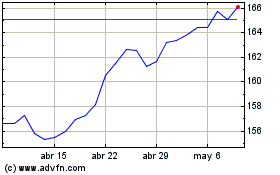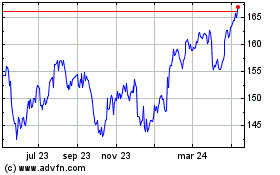Relax, America: The U.S. Has Plenty of Toilet Paper
16 Marzo 2020 - 2:19PM
Noticias Dow Jones
By Sharon Terlep
America can spare a square.
Jittery shoppers across the country are clearing shelves of
bathroom tissue as coronavirus keeps people home and threatens to
force more Americans into quarantine. But toilet paper -- unlike
some other high-demand items such as hand sanitizer and face masks
-- remains plentiful, according to the two biggest
manufacturers.
Charmin maker Procter & Gamble Co. and Cottonelle maker
Kimberly-Clark Corp. say they have ramped up toilet-paper
production and are able to make enough to meet demand.
Kimberly-Clark has started posting pictures of warehouses full of
toilet paper in some markets. The problem, the manufacturers say,
is getting the product shipped to warehouses and retailers, and
then onto store shelves, quickly enough to keep up with sales.
The shopping frenzy stirs memories for some of the global
financial crisis, which disrupted the market for, among other
things, short-term corporate debt.
"This is literally 2008 played out over toilet paper and not
commercial paper," said Justin Wolfers, a University of Michigan
professor of economics and public policy. "As long as I believe you
are going to run to Costco and buy toilet paper, I'm going to run.
And as long as you believe that I am going to run, you are going to
run. Both are rational."
People are buying extra toilet paper as a safeguard and not
using a dramatically larger amount, which distinguishes bathroom
tissue from face masks, sanitizer and other cleaners that are being
consumed in far greater quantities.
U.S. toilet-paper sales were up 60% for the week ended March 7,
compared with the same period a year ago, according to Nielsen. It
is a significant jump, but not close to the sales increases for
hand sanitizer or aerosol disinfectants, up 470% and 313%,
respectively, for that period.
Restocking inventory can take several hours or days as goods
work their way from the factory to the warehouse to shelves. The
consumer-products industry, including suppliers, manufacturers and
retailers, have overhauled supply chains over the past two decades
to be more profitable and flexible by keeping limited inventory on
hand as opposed to stocked up in warehouses. The more
cost-effective system means that when demand spikes unexpectedly,
supplies run short.
Kimberly-Clark said it has plans in place to meet increased
demand for its products, including faster production and
"reallocating inventory."
A P&G spokesman said toilet-paper shortages are sporadic and
generally temporary. He noted that on any given day in P&G's
hometown of Cincinnati, there are stores with plenty of toilet
paper and stores completely sold out.
"We have seen some temporary out-of-stocks at some retailers
given rapid consumer purchases," he said. "However we continue to
manufacture and ship products to retailers nationwide."
Write to Sharon Terlep at sharon.terlep@wsj.com
(END) Dow Jones Newswires
March 16, 2020 16:04 ET (20:04 GMT)
Copyright (c) 2020 Dow Jones & Company, Inc.
Procter and Gamble (NYSE:PG)
Gráfica de Acción Histórica
De Mar 2024 a Abr 2024

Procter and Gamble (NYSE:PG)
Gráfica de Acción Histórica
De Abr 2023 a Abr 2024
